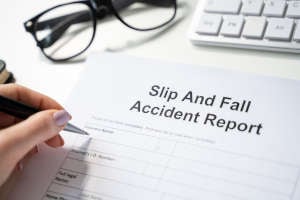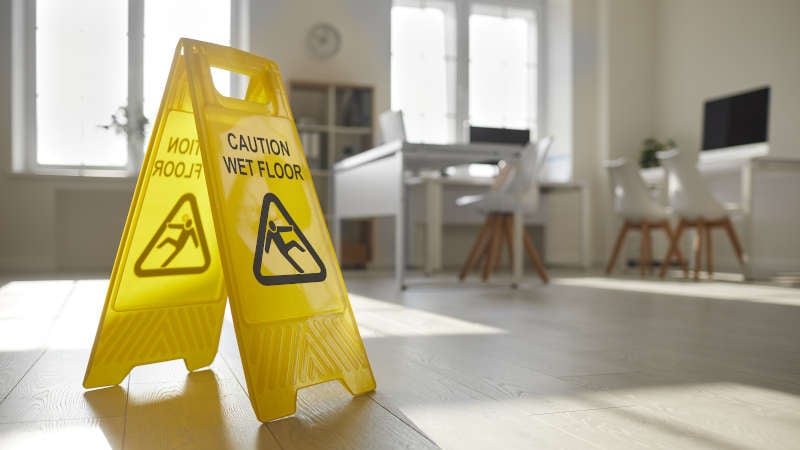Similar to legal malpractice suits, uncovered medi...
 The most common reasons for time lost at work are trips, slips, and falls. More often than any other regulation, the Occupational Safety and Health Administration (OSHA) has issued citations for infractions of the Fall Protection Standards. According to OSHA, here are a few interesting facts regarding slips and fall claims.
The most common reasons for time lost at work are trips, slips, and falls. More often than any other regulation, the Occupational Safety and Health Administration (OSHA) has issued citations for infractions of the Fall Protection Standards. According to OSHA, here are a few interesting facts regarding slips and fall claims.
Slips and falls occur when there is insufficient grip or friction between the footwear and the ground during walking. Common reasons for slips include:
According to the National Institute for Occupational Safety and Health (NIOSH) a part of the Centers for Disease Control (CDC), the following industries have the highest risk of slip, trip, and fall events:
There are effective strategies to prevent slips, trips, and falls, which can reduce the risk of these risks for both employees and employers. Fall safety and prevention should be everyone’s priority because there is a danger of injury ranging from a minor sprained ankle to a catastrophic injury or death.
Good housekeeping is the first and most crucial step to prevent falls:

This is the most challenging condition to manage. It’s natural to let your guard down for a moment and become preoccupied with unrelated ideas or several tasks.
Being hurried will cause you to walk or run too quickly, which increases your risk of slipping, tripping, or falling. Many workplace injuries are caused by taking shortcuts, not paying attention to where one is going, using a cell phone, carrying objects that block one’s vision, donning sunglasses in low-light situations, not using authorized paths, and speeding.
In the end, it’s up to each person to stay focused and pay attention to their surroundings.
Employers must supply the necessary tools, such as ladders, scaffolds, and fall protection PPE. Make sure employees wear footwear appropriate for the working environment and to keep them well maintained and free of any snow, ice, or mud.
It’s crucial to keep careful track of any incidents that do happen when you start to adopt some of these fall prevention strategies. Any slip or trip, even without a fall or harm, demonstrates that there is still an opportunity for progress. You can continue reducing risk by establishing the safest workplace possible and investigating each incident.
It is possible to prevent many slips and falls by doing your best to provide a safe workplace, adhering to the preventative strategies mentioned above, being proactive about keeping your workplace uncluttered and risk-free.
The most crucial task for the employer is creating a safe workplace. Employees that work in a safe environment have a reduced of getting hurt ill while performing their duties. Employers must “provide their employees with working circumstances that are free of known risks,” according to OSHA law.
Maintaining employee safety is not only required by law, but also morally right. People who work in facilities or on construction sites have lives outside of work, including families, friends, and social circles. Their well-being and safety should never be put at risk for financial gain. Because of this, it is crucial to prioritize safety and ensure that every worker makes it home safely each day.
Contact the experts at Leap Carpenter Kemps Insurance Agency. They have been in business for over seven decades and have licensed experts on hand to guide you on the best coverage for your organization. Call for a free quote today!
Similar to legal malpractice suits, uncovered medi...
You get all the benefits and advantages of being a...
Natural disasters and crimes can impact a business...
Leap | Carpenter | Kemps Insurance Agency provides Commercial Business Insurance, Employee Benefits, Life and Health Insurance, and Personal Insurance to all of California, including Merced, Atwater, Los Banos, Mariposa, Madera, Fresno, Modesto, Turlock, and Stockton.
CA License Number 0646081 | Licensed to do business in California, Arizona, Hawaii, Idaho, Montana, Nevada, North Carolina, Oklahoma, Oregon, Virginia, West Virginia and Washington.
© Copyright 2023 Leap | Carpenter | Kemps Insurance Agency — Privacy Policy | Terms & Conditions.
Merced Office
3187 Collins Drive
Merced, CA 95348
Phone: (209) 384-0727
Additional Contacts
Toll Free: (800) 221-0864
Fax: (209) 384-0401